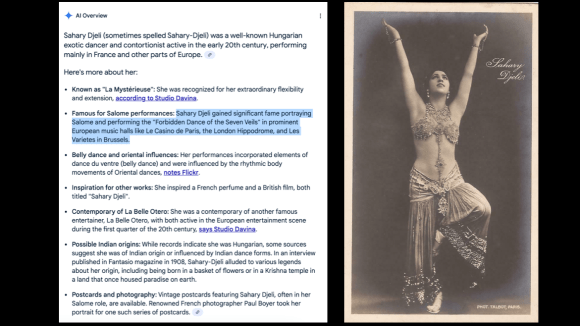I’ve recently faced some difficulty using AI-enhanced search tools. To help me understand what’s happening, I talked to a friend here in Silicon Valley.
What we call AI today is known as “Machine Learning” within the computer tech industry. Check out this article for more info. Machine learning increases computing efficiency. From Google Search for general information to shopping sites like Amazon.com, we have been using software enhanced by machine learning for a long time.
Blow: Three dance stars of 1905-1914 – From Left: Maud Allan, La Belle Otero, Mata Hari
 Has AI destroyed Google Search?
Has AI destroyed Google Search?
The other day, I went to the web to try and find a birthdate for an early 20th-century dancer, Sahary Djeli. I realized that my research folder didn’t have that info, so I thought as simple Google search would net me the date quickly and efficiently.
However, to my shock and amazement, MY website came up as the first place to look for information about Sahary. Waves of emotion washed over me as I considered how this could have happened.
First, I was completely gobsmacked. I let out a mighty WTF as I stared at the screen. After my third re-read, I took a screen grab to share here.

My next wave of emotion was heavy disappointment. Every day, I spend a small bit of time actively performing archival research. Slowly digging through digitized archives, hunting for details for my “big three” projects.
- The Visual History of Belly Dance
- Belly Dance at World’s Fairs and International Exhibitions
- Salomania: 1905-1914
These three projects overlap like this:
 Over the past 150 years, from the time belly dance reached the US shores until today, it has been rare for dancers to achieve notoriety or even stardom. As I dig through the archives, I’m finding that most performers didn’t leave footsteps in the sands of time.
Over the past 150 years, from the time belly dance reached the US shores until today, it has been rare for dancers to achieve notoriety or even stardom. As I dig through the archives, I’m finding that most performers didn’t leave footsteps in the sands of time.
What does this mean for us? Short blog posts are getting flagged as key reference sources. While I’m confident in my abilities as a researcher, many other sites AI serves are filled with errors. And AI search tools can’t always tell what’s myth and what’s truth.
Image Misattributions
The most common error on websites is misattribution. Because Sahary wears a typical dance costume for the date, she is frequently labelled with the wrong name. But other information can be questionable as well. As a reader, keep in mind that secondary sources should always be taken with a grain of salt.

I recently discovered a dance archives located in Germany, Deutsches Tanzarchiv Köln with a page devoted to Sahary Djeli. The image above is a collage of pages from a rare scrapbook from 1908.
Their collection of information would be a delight to explore in person, but alas, my budget doesn’t stretch to European research junkets.
But here’s my real question, “Why didn’t AI choose to show me this more accurate and prestigious source?”
So in my updated fact sheet about Sahary, includes facts such as, we don’t know when she was born, but she is orginally from France, not Hungry or India as was reported in the press in 1908. At the outbreak of war in 1914, Sahary left for America.
Now that I know that she came to the US to perform, I can now hunt for her here. Something I never thought to do when I was researching her purely as an example of a “Salome Dancer.”
Ultimately, my quest for a date made me question how I search for information on line. With these new AI tools, it’s actually getting more difficult to find the collections, libraries, and archives where primary source materials are stored.
AI Slop vs. Primary Source Material

The other AI issue I’ve recently faced is the presentation of AI-created or enhanced images as historical pieces. One of my Facebook Group participants shared the two pictures above right and stated that they found these two ancient Egyptian bead dress pictures on the web.
My first instinct was to laugh – but then I realized, there are probably people who really believe that these AI-generated dresses are actually real.
In the safe conversation space of the FB Group, I was able to pull out the two images on the right from major museums in the Boston Fine Arts Museum and in London’s Petrie Museum.
AI might be a great tool to use in the future, but until it reaches a point where it points to more reliably accurate sources, just take a moment, like I did, to question the results.
It’s flattering that AI thinks of me with such high regard. But I know there are more high-quality information sources than my little blog.
Best of luck in your own research adventures,
Dawn Devine ~ Davina
Aug. 2025
















 Over the past 150 years, from the time belly dance reached the US shores until today, it has been rare for dancers to achieve notoriety or even stardom. As I dig through the archives, I’m finding that most performers didn’t leave footsteps in the sands of time.
Over the past 150 years, from the time belly dance reached the US shores until today, it has been rare for dancers to achieve notoriety or even stardom. As I dig through the archives, I’m finding that most performers didn’t leave footsteps in the sands of time.



